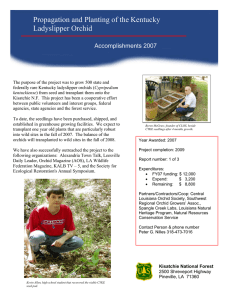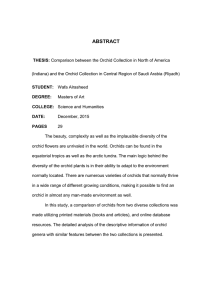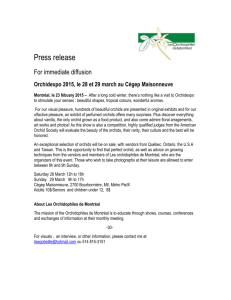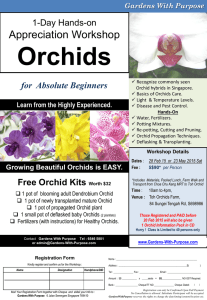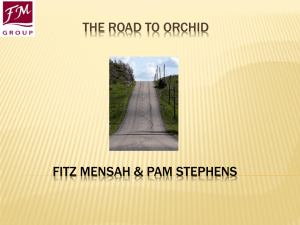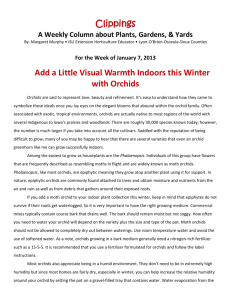A U ’ F
advertisement
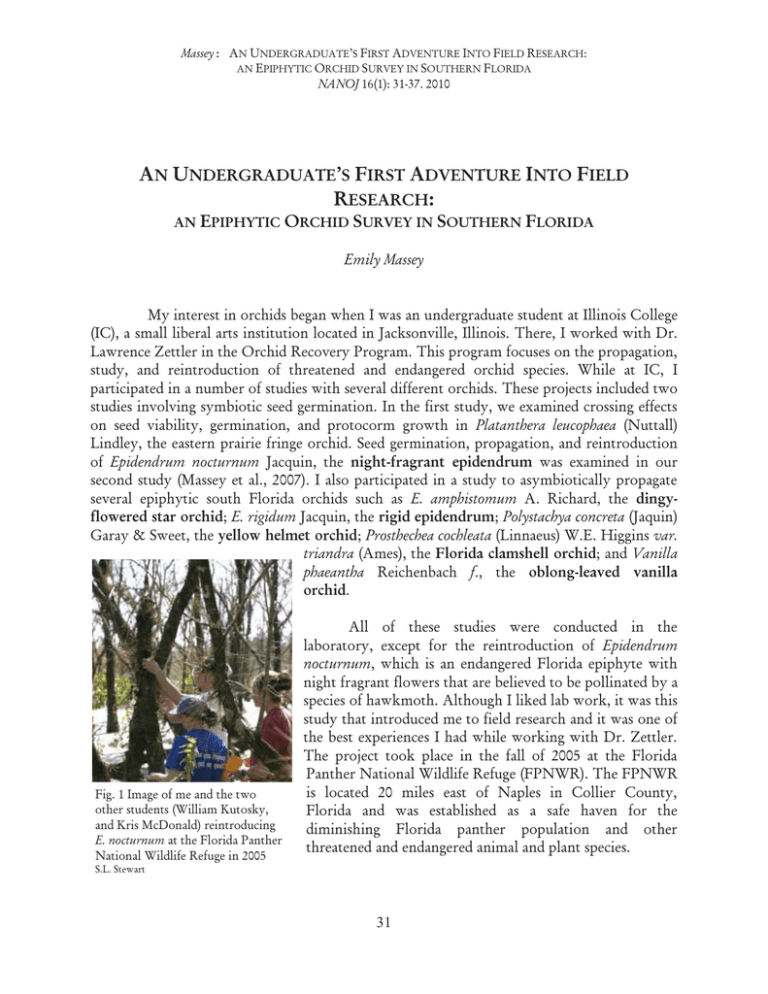
Massey: AN UNDERGRADUATE’S FIRST ADVENTURE INTO FIELD RESEARCH: AN EPIPHYTIC ORCHID SURVEY IN SOUTHERN FLORIDA NANOJ 16(1): 31-37. 2010 AN UNDERGRADUATE’S FIRST ADVENTURE INTO FIELD RESEARCH: AN EPIPHYTIC ORCHID SURVEY IN SOUTHERN FLORIDA Emily Massey My interest in orchids began when I was an undergraduate student at Illinois College (IC), a small liberal arts institution located in Jacksonville, Illinois. There, I worked with Dr. Lawrence Zettler in the Orchid Recovery Program. This program focuses on the propagation, study, and reintroduction of threatened and endangered orchid species. While at IC, I participated in a number of studies with several different orchids. These projects included two studies involving symbiotic seed germination. In the first study, we examined crossing effects on seed viability, germination, and protocorm growth in Platanthera leucophaea (Nuttall) Lindley, the eastern prairie fringe orchid. Seed germination, propagation, and reintroduction of Epidendrum nocturnum Jacquin, the night-fragrant epidendrum was examined in our second study (Massey et al., 2007). I also participated in a study to asymbiotically propagate several epiphytic south Florida orchids such as E. amphistomum A. Richard, the dingyflowered star orchid; E. rigidum Jacquin, the rigid epidendrum; Polystachya concreta (Jaquin) Garay & Sweet, the yellow helmet orchid; Prosthechea cochleata (Linnaeus) W.E. Higgins var. triandra (Ames), the Florida clamshell orchid; and Vanilla phaeantha Reichenbach f., the oblong-leaved vanilla orchid. Fig. 1 Image of me and the two other students (William Kutosky, and Kris McDonald) reintroducing E. nocturnum at the Florida Panther National Wildlife Refuge in 2005 All of these studies were conducted in the laboratory, except for the reintroduction of Epidendrum nocturnum, which is an endangered Florida epiphyte with night fragrant flowers that are believed to be pollinated by a species of hawkmoth. Although I liked lab work, it was this study that introduced me to field research and it was one of the best experiences I had while working with Dr. Zettler. The project took place in the fall of 2005 at the Florida Panther National Wildlife Refuge (FPNWR). The FPNWR is located 20 miles east of Naples in Collier County, Florida and was established as a safe haven for the diminishing Florida panther population and other threatened and endangered animal and plant species. S.L. Stewart 31 Massey: AN UNDERGRADUATE’S FIRST ADVENTURE INTO FIELD RESEARCH: AN EPIPHYTIC ORCHID SURVEY IN SOUTHERN FLORIDA NANOJ 16(1): 31-37. 2010 For about a week, two of my lab mates and I visited the refuge to reintroduce Epidendrum nocturnum seedlings propagated in our lab. At the time of the reintroduction, the cool, murky water at most sites was waist and chest deep for my 5’2’’ stature (Fig. 1). You definitely had to be careful where you were walking, or I should say feel around where you were stepping, because you sure could not see through the water beneath your feet. This was due to the presence of tannins that darken the water into a coffee-like brew. This was a very Fig. 2. One of the many swamp buggies in the fleet. intimidating project and I was a little apprehensive at first. We were venturing out into the wilderness, with the possibility of running into an alligator or worse, and we were on foot. However, the longer we worked, the less this seemed to matter. I may have had to wring out my clothes every night of the trip, but this field research experience was one of the most memorable moments of my life. I had many other new experiences as well. I got to take my first spin in a swamp buggy, which is basically a very large, open-air vehicle resembling a monster truck without a top (Fig. 2). Another new experience and probably one of the more amusing moments of this excursion took place when a local news reporter and cameraman came out to the refuge to capture our efforts. The cameraman must have known what he was getting into because he showed up wearing boots and worn clothing. Perhaps the reporter should have consulted with him before he dressed that morning because he wore shiny dress shoes, khaki pants, a very neat button down shirt, and a tie. Needless to say the reporter was a bit out of his element, but he was a good sport about it. With a smile, he waded out into the swampy water 32 Massey: AN UNDERGRADUATE’S FIRST ADVENTURE INTO FIELD RESEARCH: AN EPIPHYTIC ORCHID SURVEY IN SOUTHERN FLORIDA NANOJ 16(1): 31-37. 2010 after a few minor wardrobe adjustments (i.e., rolled up his pant legs a good three or four inches and donned a pair of borrowed boots) to film a portion of the piece. We eventually reintroduced 43 Epidendrum nocturnum seedlings back into the wild. Unfortunately, this part of Florida had just been damaged by Hurricane Wilma. This stripped many of the trees’ upper canopy, exposing the seedlings to higher light levels and fewer than 10% of our reintroduced seedlings remained one year later. Another issue was that we had little idea of what trees to affix these seedlings and what microhabitat conditions they needed (i.e., epiphytic assoc-iates, location on the tree, and the light levels required). The locations we selected for these plants were based on observations made by the staff at the refuge and students performing research on site. The FPNWR is home to about 27 orchid species in 17 genera with many of these species being threatened or endanger-ed. It is possible that the survival of many of these species hinges on the habitat (i.e., tree species in the area), the microhabitat (i.e., substrate of establishment and epiphytic associates), and other factors (i.e., light level to which they are exposed). However, little to no data has been collected on the orchid microhabitats of these species at the refuge. Fig. 3. Image of one transect at the study site. This leads us to the study at hand. My project surveyed an area of the FPNWR for epiphytic orchids and the mircohabitats associated with them. The site was classified as a slough transitioning to a floodplain swamp and was believed to consist mainly of pop ash (Fraxinus caroliniana), pond apple (Annona glabra), and baldcypress (Taxodium distichum) for epiphytic orchids and catalogued the microhabitats associated with them. Some of the species I surveyed were orchids that I had worked with in the Orchid Recovery Program back in Illinois. Again, I was working in some of the same sites I had visited two years ago, but the terrain was slightly different. For one, the atmosphere was very different. The cooler fall weather had been replaced by the hot and very humid summer months. The site was no longer flooded and I could see where I was stepping most of the time. Despite this, I still encountered some obstacles. About once a week, I experienced tiny paper cuts on my exposed arms and legs, cuts that were the direct result of the very tall and sharp saw-grass (Cladium 33 3 Massey: AN UNDERGRADUATE’S FIRST ADVENTURE INTO FIELD RESEARCH: AN EPIPHYTIC ORCHID SURVEY IN SOUTHERN FLORIDA NANOJ 16(1): 31-37. 2010 jamaicense), which in some spots was taller than me. The saw-grass was also an area of concern because alligators often find this habitat to be conducive for nest building. I encountered many more mosquitoes than I had in the fall and began each day by spraying myself with bug spray. Fortunately the only animals I came across were deer and a couple of harmless snakes. The data were collected in June and July of 2007 by another student, Cabrina Hamilton, and me. Data were collected for this project along 30 transects, 140 m long and 10 m apart for a total area sampled of 42,000 m2 (Fig. 3). An orchid was counted in the survey if it was within 1 meter from the ground (Fig. 4). A midday light measurement was also collected for each plant using a Sper Scientific, Broad Range LUX/FC meter (840022) and recorded in Lux. Some other data collected consisted of the phorophyte (i.e., a plant on which epiphytes grow) for each orchid, the substrate on which the orchid was established (i.e., moss, bark of host tree, lichens, or a combination of any two), the diameter of the part of the tree closest to the orchid was measured in centimeters, and the orientation of the orchid in regards to substrate tilt (i.e., located on the trunk, an angled or a horizontal limb, or on a fallen tree) along with the directionality of the orchid (i.e., facing N, E, W, S, NE, NW, SE, and SW). The orchid’s epiphytic associates were measured (i.e., vascular plants like bromeliads and ferns and non-vascular organisms like lichens and mosses). We also subjectively determined the percentage of the area in the microhabitat they comprised and estimated the number of species present. 4 5 6 7 Figs. 4-7. Mature orchids sampled at the survey site. Campylocentrum pachyrrhizum is an example of a leafless orchid [5], Prosthechea cochleata var. triandra an orchid with leaves and visible pseudobulbs [6], and Epidendrum amphistomum an orchid with leaves and no visible pseudobulbs [7]. 34 Massey: AN UNDERGRADUATE’S FIRST ADVENTURE INTO FIELD RESEARCH: AN EPIPHYTIC ORCHID SURVEY IN SOUTHERN FLORIDA NANOJ 16(1): 31-37. 2010 8 9 Figs. 8, 9. Mature orchids in flower during the study: Epidendrum amphistomum [8] and Polystachya concreta [9]. The orchids themselves were divided into three categories based on their morphological differences: leafless (Fig. 5) (i.e., Campylocentrum pachyrrhizum (Reichenbach f.) Rolfe, crooked-spur orchid; ribbon orchid and Harrisella porrecta (Reichenbach f.) Fawcett & Rendle, the leafless harrisella), orchids with leaves and visible pseudobulbs (Fig. 6) (i.e., Encyclia tampensis (Lindley) Small, the Florida butterfly orchid; P. concreta; and P. cochleata var. triandra), and orchids with leaves and no visible pseudobulbs (Fig. 7) (i.e., 7 8 E. rigidum). They were further subdivided 9into 6Epidendrum amphistomum, E. nocturnum, and their stages of development. The plants without leaves were separated by the number of green roots: seedlings (>3 green roots), juveniles (3-5 green roots), and mature plants (with flowering or fruiting bodies or >5 green roots). The plants with leaves were separated into seedling (plant ≤0.5 cm), juvenile (plant ≥0.5 cm and ≤10 cm), and mature (flowering or fruiting bodies or plant ≥10 cm) plants. The number of green roots (leafless orchids) and the number5of green leaves were counted (orchids with leaves). If a plant was in flower or fruiting, 7 then we also counted the number of flowers and capsules. During the study the only orchids in flower were E. amphistomum (Fig. 8) and P. concreta (Fig. 9) and the only orchid seen in fruit was E. amphistomum. We sampled 419 orchids in total with a majority of the orchids surveyed being juveniles with fewer mature plants and seedlings. Of the mature plants, E. amphistomum were fruiting (2) and flowering (7). Polystachya concreta was also in flower (1). Most of the orchids surveyed were found on pop ash (Fraxinus caroliniana) (371) with 100%, 89%, and 88% of them being leafless, leaves with pseudobulbs, and leaves without pseudobulbs respectively. Leafless orchids were observed on trunks or branches <51 cm in diameter whereas orchids with leaves and visible pseudobulbs, as well as orchids with leaves and no visible pseudobulbs were noted on trunks and branches between 11-110 cm. All of the seedlings sampled occurred on moss, and it appeared that the juvenile and mature plants were either on moss or a combination of moss and bark. A majority of the epiphytic orchids without leaves were found on horizontal substrates, whereas orchids with leaves were affixed to branches/trunks at a 45 degree angle or a vertical position. Moreover, the majority of the orchids were oriented 4 8 9 35 Massey: AN UNDERGRADUATE’S FIRST ADVENTURE INTO FIELD RESEARCH: AN EPIPHYTIC ORCHID SURVEY IN SOUTHERN FLORIDA NANOJ 16(1): 31-37. 2010 on substrates that received little direct sunlight (N, NE position). Many of the epiphytic associates consisted of mosses and ferns (e.g., resurrection fern, Pleopeltis spp.), as well as bromeliads, vines and occasionally lichens (Massey et. al., 2008). Taken together, it appears the orchids at this site are established on moss or a combination of moss and bark of the phorophyte, which is largely pop ash (F. caroliniana) with all of the seedlings being established on moss. These orchids were often facing in a northerly or northeasterly direction and either on branches or trunks tilted at an angle or vertical for the orchids with leaves and horizontal for the leafless orchids. Currently, the Orchid Recovery Program at Illinois College is propagating many of the orchid species surveyed in this study with the hopes of reintroducing them. Despite the thoroughness of this study, more research is needed before we can give orchids reintroduced in this area a fighting chance. For instance, the data in this study seem to indicate that the epiphytic orchids grow prominently on pop ash (F. caroliniana). We are unsure if this result is due to there being more trees of this species in the area or if there is a physical (i.e., bark texture, moisture capabilities, or the arrangement of the canopy cover) or chemical association between the orchids surveyed and this species of tree. A future study could survey the trees in this area or analyze the bark of all of the species of trees indicated in this study to better understand this relationship. Also it seemed that despite the orchids growing in close proximity to lichens few of them were established on or very close to lichens. Perhaps there is a reason for this dissociation. I suggest further studying of the orientation and tilt for these and other orchid species and more data collection of the phorophytes and branch diameter, especially for the orchids with leaves. In addition to these factors, studies regarding the stage of the orchid best suited for reintroduction should be assessed. Our data indicate that juveniles (i.e., plant ≥0.5 cm and ≤10 cm) were highly abundant at the site so perhaps plants should only be reintroduced if they are at a juvenile or mature plant stage. Further study of these threatened and endangered orchids is needed. Many of these species are in danger of being poached, having their habitats destroyed by humans and hurricanes, and having their territory encroached upon by exotic species. Hopefully, this study will promote future research aimed at improving the survival of both Florida orchids and other threatened and endangered species through reintroduction or better protection and management of their habitats. Acknowledgements Many people were influential from the conception of this study to completion of this manuscript. Cabrina Hamilton for her aid in data collection, Dr. Lawrence Zettler for asking me to join his lab and fostering my love of research, Larry Richardson and the U.S. Fish and Wildlife Service for allowing me to come and work on the Florida Panther Refuge, Dr. Scott Stewart for helping with the formation of the study, Illinois College and the Charles and Dorothy Frank Scholarship for funding my study, Dr. Elizabeth Rellinger for her all of her patience in helping me with statistical analysis, the refuge staff for their assistance during the survey, and for everyone who spent their precious time reviewing this article. I kindly thank all of them for their support. 36 Massey: AN UNDERGRADUATE’S FIRST ADVENTURE INTO FIELD RESEARCH: AN EPIPHYTIC ORCHID SURVEY IN SOUTHERN FLORIDA NANOJ 16(1): 31-37. 2010 Emily Massey, Department of Environmental Horticulture, University of Florida, PO Box 110675, Gainesville, FL, 32611. emassey@ufl.edu As for my future plans, this study was a great experience and while I still enjoy laboratory work, it really sparked my interest in field research too. Currently, I am a graduate student enrolled at the University of Florida earning my Master’s degree in Environmental Horticulture. My proposed project examines water relationships, specifically the affects of stress, and growth in two tree species. Although this is not based in ecological restoration, this study will provide a good basis for future research. Eventually I plan on returning to more ecologically based projects and securing a research position. Literature Cited: Massey, E.E., K. Hamilton, S.L. Stewart, L.W. Richardson, and L.W. Zettler. 2008. Substrate preferences of epiphytic orchids (seedlings, juveniles, mature plants) within the Florida Panther National Wildlife Refuge. Illinois State Academy of Science 101: 62-63. Massey, E.E. and L.W. Zettler. 2007. An expanded role for in vitro symbiotic seed germination as a conservation tool: Two case studies in North America (Platanthera leucophaea and Epidendrum nocturnum). Lankesteriana 7(1-2): 303-08. 37
